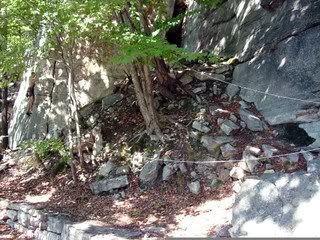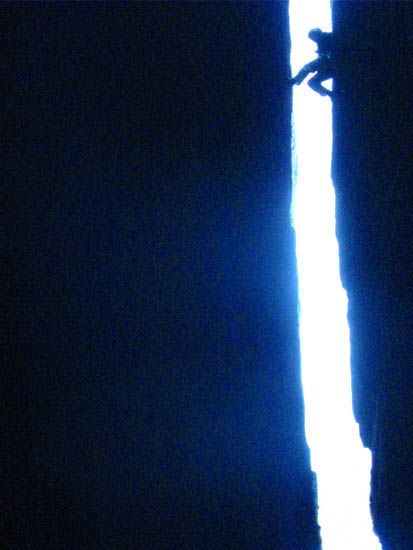
Nearly anyone who's been a visitor to the Gunks in the last several years recognizes the location in the picture above. It's the "Bunny Slope!" Located in the Trapps, this steep section abuts the rock wall as you come into the Uberfall area.
It's not actually part of the cliff, as it consists of a mixture of loose rocks and dirt. Corralled by a low fence of Gunks conglomerate laid down by volunteers on a National Trails Day in the 1990's, the slope is anchored in place by a few small trees and partially buried boulders. It's not really talus, nor is it woodland. The Bunny Slope inhabits a sort of netherworld between rock and (carriage) road.
I've only been a preserve member for the last four seasons, but I've passed this spot hundreds of times. As for the natural beauty that dominates the preserve, this spot seems a bit of an apparition. Because the slope is very fragile, even the smallest amount of interaction with humans(a child allowed to scramble on it, a dog left to dig for buried treasure, or a belayer with a less than average level of common sense), the majority of the section is roped off with accessory cord, and hung with a sign that advises "Slope Restoration in Progress," reminding us to stay off.
I assumed that the timeline for this particular restoration process was to be measured in generations, if not centuries. Being that the ethic of the Mohonk Preserve is to allow the land to regenerate to a pre-industrial era state, I just thought that over time - lots of time - the idea was that silt would wash down from the enormous off-width fissure behind the Herdie Gerdie block, eventually creating..... well, something more attractive than what we see above, at least.
Not to be so! In fact, the revolution has already begun. Volunteers who work on trail maintenance in the climbing areas of the preserve have spent the last few Sundays preparing for major restoration of the Bunny Slope.
A little over a month ago, we began harvesting rocks form the talus slope to the west of the area. Most of these have already been used though, in the creation of a "patio-type" surface at the base of the Herdie Gerdie Block, which was phase I in this project - to preserve, protect and highlight an area what is tantamount to the "Gateway to the Gunks."
Some might think that this is all simply an unneeded "beautification project;" even unethical, since the preserve looks to recreate an environment reminiscent of the early 19th century. But they would be incorrect in that supposition. The layer of rock actually serves to protect the fastly-eroding slope that fronts that highly-trafficked spot.
As you can see in the photo someone is just starting up "Nurdy Gerdie"(a/k/a "Dogs in Heat," a 5.10+(crack around the corner is off-route) face climb. That, and the two more popular routes on that short bit of rock easily see more than a dozen ascents on an average weekend day in season, frequently groups of three or more, including posses of families and other bystanders. People scamper over that short slope, set out picnics, kick at the dirt out of bored habit as they lock off their hang-dogging partner.....
In short, the area sees a tremendous amount of abuse, which is only increasing as gym climbers not yet (or never to be) experienced with placing gear on lead flock to the easily accessible top-roping climbs of the Gunks.
It wouldn't be so much of a problem had a few poor old trees not had the foresight to realize how much the neighborhood would change when they set down roots before most of us were saplings.....
Root damage.
It's an aspect of conservation that even the most conscientious of us may be unaware of. You see - when we tread over a tree's root system, we wear off miniscule bits of the protective layer that is utterly necessary to insure the health and natural life-span of that tree. Over time, any tree with exposed roots (which is a prevalent feature in the Shawangunks area) will suffer due to this loss of "skin." With extreme abuse, the tree simply cannot survive.
The Herdie Gerdie block is partially popular because it offers shade from a hot summer's sun. That shade comes from the few trees growing in the vicinity. Trees that see such a tremendous amount of irritation to their roots that they surely can't stay healthy if the trauma were to continue.
To counteract this problem, volunteers placed rocks within the spaces of the labyrinth of roots. Building up a sub-floor that allows for proper drainage(for built-up moisture would rot the roots and kill them even more readily than being trammeled), the "patio" protects the tree roots while at the same time also provides climbers a safer platform to work from. No more tripping over intertwining roots as belayers shift stances. Climbers coming off from a low level won't risk an ankle-breaking impact by hitting an uneven surface.
After completing that work, we went out in search of more rocks to use in our reclamation project of the Bunny Slope. Last Sunday, we spent an entire morning trundling from the lower talus slope in the vicinity of the "Stairmaster," or East Trapps Connector Trail, as it is officially know as.
As most people know, trundling rock is a BIG no-no at the Gunks. It's dangerous too, as impact from even an incredibly small rock coming from above can be fatal.
And that's just for innocent bystanders! Imagine standing in the talus field, amidst a herd of heavy smallish boulders(Gunks Conglomerate, the local breed of rock) weight 155 pounds per cubic foot). Each rock rests upon the one below it, sometimes solidly. Sometimes very precariously. Sometimes the top rock anchors the ones below.... Move one - and you have potentially upset the masses. Move the WRONG one, and the herd stampedes!
I was well aware of this aspect of talus-picking, as I got my on-the-job. I didn't want my tombstone epitaph to read "Trampled While Trundling." Even one of those bulls on the run would have snapped my leg like a tiny twig if it had cut loose. The fact that the rocks crash against each other, emitting a smell very much like that of explosives, also helps put everything in perspective.
In fact, I DID have a close call at the day's start, when a rock reoriented itself and landed on my pinky. I hadn't even touched it; simple vibration from....somewhere... seemingly launched the motion, and it made a minor adjustment. The pain was severe, and I really was worried about what I'd find when I removed my workglove. The rock had been only about the size of a Honeydew melon(which meant it weighed somewhere around 20 pounds), but I half-expected to see a mangled and bloody fingertip. I was very relieved to see just a red bruise.
In case you wonder why I mention all this - it's to apprise anyone not aware of the inherent danger. Do NOT try this at home(if your home away from home is an area where rocks hang out).
One unintended benefit of the trundling is that one intentional avalanche opened up a beautiful vista in the lower talus field we were working in. Al, a longtime trail crew volunteer, had nudged two small rocks(by trail crew standards, though the rocks weighed about 70 pounds each), and the shift set in motion a rock slide that brought down a great cache of sizable rock. We'll gather and use them for the retaining walls we create on Bunny Slope.
If you happen by the Connector Trail in the next few days, you may notice the pile. They sit at the talus base about 20 feet west of the wooden trail marker sign. You would recognize them because they seem to have been attacked my a Tick Marking Maniac! White chalk-like scars, about three to four inches long, seemingly point to many of the corners on these rocks. The pile has the appearance of a natural rockslide, which it was, even though started with a helping hand.
Bring your eyes upward to the large multiple-trunked tree that grows about 40 feet up from the carriage road, and notice the wonderful rock ledge the tree is growing from. It almost has the appearance of a sculpted oriental garden...on a grand scale, of course.
Another benefit that came of Al's slide was the displacement of "a few good men;" boulders that are going to be the cornerstones of our project. By moving two melon-sized rocks, the cascade let loose about 50 others, which in turn allowed the downward march of some hefty hunks of the Gunks. These rocks a BIG - probably weighing close to a thousand pounds and the size of dorm refrigerators. Earlier this week, Dick Williams, who leads the trail crew, worked with another preserve volunteer, on the removal and transportation of these boulders. They are to be brought down to our work-site in the jaws of a bull-dozer type machine.
You'll see the smaller rocks we have gathered already at the work area; we've plied them on the edge of the carriage road, near but not impeding, at the starts of Bunny, Retribution, Bo Solution and Nosedive. This rock pile consists of an estimated eight tons of rock! Thanks to ranger Bob Elsinger, who assisted in loading his Preserve tuck and hauling them to the destination. Eight times. The pickup had a load limit of one ton before the bed began to bottom out, and so back and forth we went. This constituted about 3 1/2 to 4 hours of steady work.
So - If weather permits, and enough volunteers arrive, we will begin placing these rocks on Sunday. This is going to be hard labor, and strong people are needed to do the job. If you've been wondering about how you can give back in a place that has given you so much, this might be your opportunity! We meet atop the Steel Bridge at 9am.
~~~~~~~~~~~~~~~~~~~~~~~~~~~~~~~~~~~~~~~~~~~~~~~~~~~~~~~~~~~~~~~~~~~~~~~~~~~~~~~~~~~~~
If you enjoy my blog and would like to subscribe through RSS, you can click the FeedBurner Badge here. Thanks for your support! ![]() Subscribe in a reader
Subscribe in a reader







3 comments:
Hi, I'm Pandora. Anyway, I found you using the interests search thing (clearly for lack of better words.) I think it is so cool that you are into nature and conservation, especially being a girl...none of my friends would dare go camping, bike riding, kayaking or doing any kind of physical labor. So, kudos.
Thanks, Pandora. One thing I discovered long ago was that, if I wanted to do something, I should just go out and do it. Without that effort, I'd have never done any of the things that have made my life interesting. So - if there's something you've wanted to try and didn't, because you would have done it solo - let go of the ties that bind and get out there. That's how you get the magical brew started!
Oh no, I do things on my own. I go on trips alone, I go bike riding almost every day and I prefer to do it solo. I'm a loner it's just from time to time I wish I had a girl that would accompany me...that way I don't have to worry about a guy hitting on me. The only thing I will not do alone (yet) is kayaking...done plenty of kayaking but I'm not a strong swimmer. Thanks though!
Post a Comment